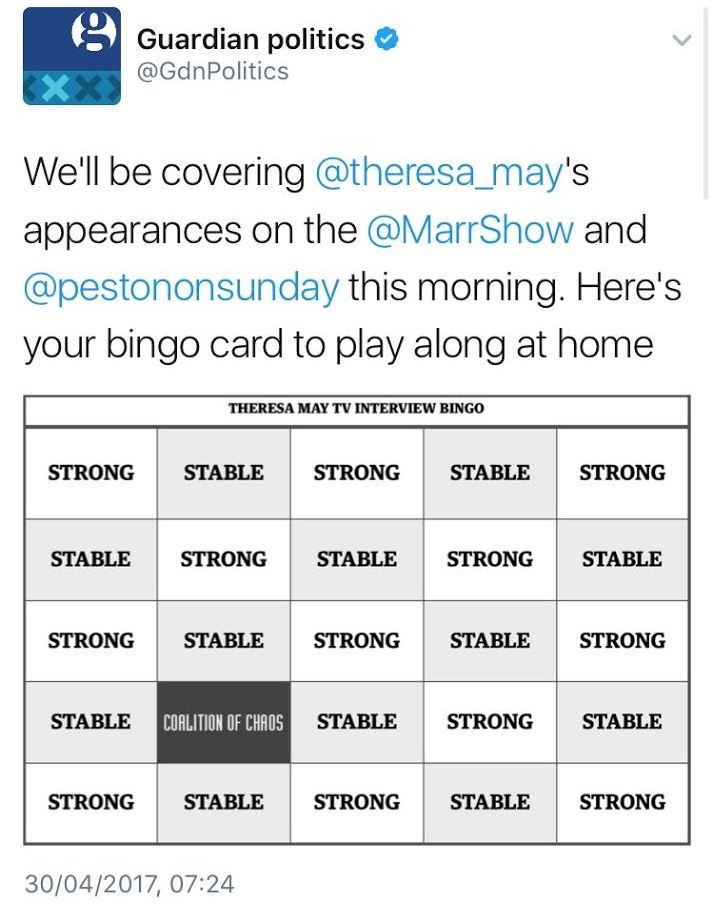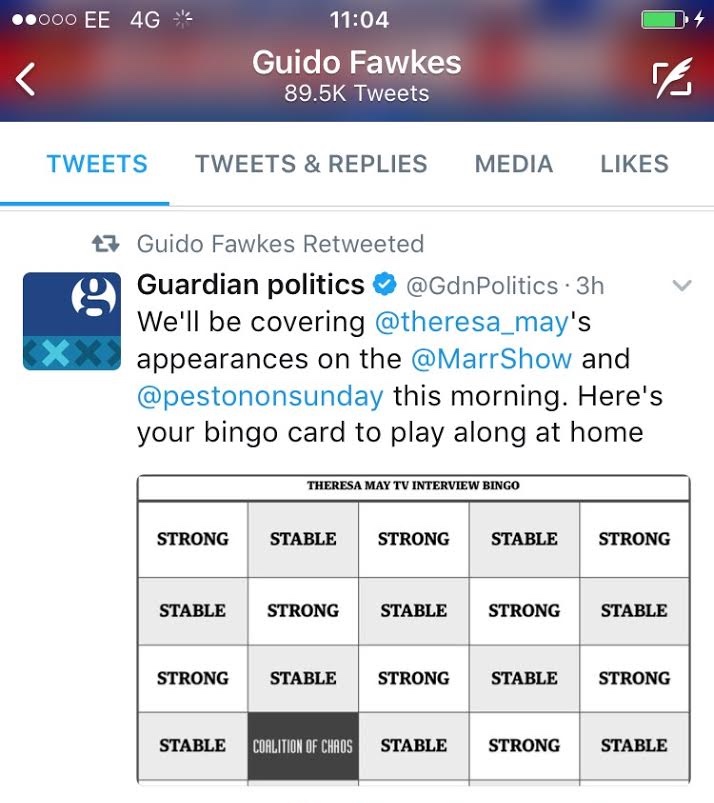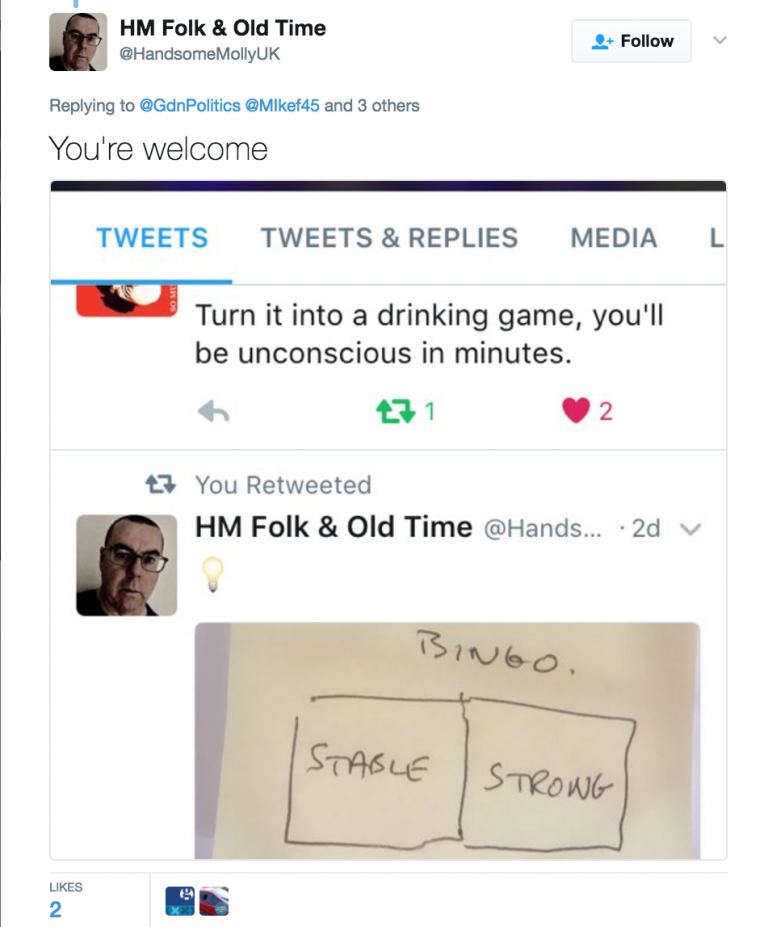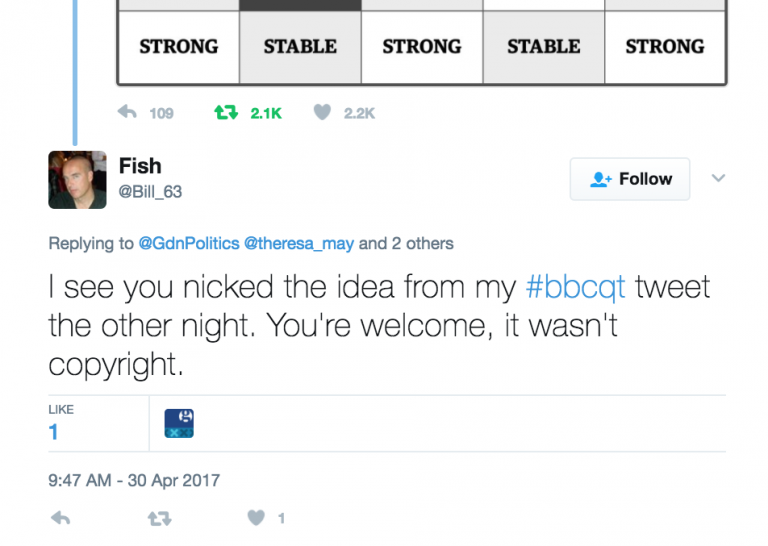“You are part of our gang” – running news social media accounts during an election campaign
Having run social media accounts for both the Mirror and the Guardian during election and referendum campaigns, here’s a long rambling brain dump about the whole thing…
I suppose one of the things that has driven my career over nearly two decades now is the nagging question that online should be able to do something just a little bit more than reproduce the article and video and audio formats that we already have. That instant feedback loop with the audience, that ability to see intent in search terms or chatbot messages, the way that we can deliver slightly different experiences if we know something about you or where you came from. All those things fascinate me. And when people talk about “new formats” from news brands, often they think about interactivity or javascript widgets or ‘Snowfall’, but I’m just as interested in how you commission things with audience-need at their heart, with a tone of voice that suits the medium.
Elections are funny times. People in politics and the media get very jittery about the possibility of making a gaffe, and so political parties try and tightly control the message. Media organisations are no less wary about their mistake becoming a story. It can often make it all a bit sterile.
I’m fascinated with tone and how you signal to people that you are a news brand that they will enjoy reading, can trust, and will want to read more of. I wanted to just look at an example from today to illustrate this.
We’ve got some pretty established formats for political coverage in print and on the web. There is the straight news article, the colour piece where a reporter wanders around taking the temperature of a specific location, there’s the long-form interview. There are a couple that really deviate from straight reporting though. First up, the political cartoon. Whatever you think of their respective merits, people like Steve Bell, Martin Rowson or Matt-nails-it-again are there to sort of make you laugh but sort of make a point. They are part of the fabric of your brand, the kind of thing your most loyal and most regular readers often love and identify with. And then there’s the political sketch. Again it usually is making a broad-brush point about character or policies, but in a tone and register that isn’t straight journalism. And so I always wonder, what are the digital equivalents of these? What are the formats that play with and stretch our existing understanding of “putting articles online” and fulfil that same sort of function with the audience?
Take this tweet from this morning:

Now, it must have been good, because in among the 2,000+ retweets it has had so far was one from Guido Fawkes, and they once called me “possibly the most over-rated person on social media.”

It was a pretty hastily executed shower-thought this morning, and not even that original – several people have gently pointed out the Guardian had ripped their idea off, and we got into a bit of “brand banter” with The New European over one they had produced.



This kind of tweet doesn’t generate any ‘clicks’ – there was nothing to click through to – but by producing something with sharing in mind, the idea was to advertise the fact that we were covering politics live on a Sunday. We don’t normally at the Guardian – Andrew Sparrow needs some rest – but today we had me on the Twitters and Haroon Siddique on the live blog. 2,000+ retweets is a lot more than we usually get for the @gdnpolitcs account, which features automatically tweeted headlines from our news and politics opinion, and then manually curated retweets from the Guardian & Observer’s leading political editors, reporters and columnists.
You also can drive an uptick in followers with this sort of tweet. Like the political cartoon, like the political sketch, like the opinion column you know your loyal core audience are going to love, you want to produce tweets like this that resonate. That make the reader feel, “yes, I am part of this club, I belong to this tribe.”
So I think that’s all very good.
But.
(There’s always a but…)
In the olden golden times, if you annoyed people, it was pretty much kept behind the scenes. The green ink letter. The phone call to the switchboard. Now, all that happens in public. One of the first replies to that tweet this morning, which sits right underneath it, is “Nasty little effort of yours, isn’t this?”
Nasty? I mean, you might think it isn’t Pulitzer Prize worthy, or even that funny, but is it really ‘nasty’? Someone else called it “Another example of #Guardian extreme left bias”. For somebody else it was more evidence that we run “The most appallingly biased twitter account out there”
Is it?
Appallingly biased?
As ex-BBC News head honcho Richard Sambrook put it in a recent panel talk about the way the British press covered Brexit, for decades now the British people have had regulated broadcasters who are meant to uphold strict impartiality, and a highly partisan and lively press, and most British people are perfectly happy with that arrangement. Wouldn’t you expect the politics coverage of the Guardian to be primarily about the progressive values that Guardian readers have? Isn’t that why they buy the paper and visit the site?
I love measuring things online, though. And there is something intangible about this. You can see that people loved a tweet because they retweeted or liked it. You can look at the big number there, the handful of disparaging replies, and conclude that, yes, your editorial hunch was right, this idea would chime with your audience.
But what you can’t measure is if you are having an impact on how seriously people are taking the other reporting. Is there a silent constituency who are slightly dismayed at the Guardian politics feed taking a lighter tone every now and then, about it being playful? It’s not sign-posted in the same way a Rowson cartoon or John Crace sketch is.
And what everyone else can see is loads of negative responses. To everything you do, ever, on social media. Loads of negative responses. Relentlessly. Having covered the #Indyref, 2015 election, Brexit referendum and now #GE2017, it’s basically been four years of people telling me non-stop that everything I’ve posted on the internet is wrong or biased. Fab.
That comes with the territory. I do worry though when I see people post replies like someone did today to that tweet, saying “Shame you’ve given up on balanced reporting, journalism in the Guardian is generally good” to what seems, to me, self-evidently a jokey dig at the repetitive way May has been campaigning, that could be made without criticism in many other formats. Does the social media representation of your news brand have to only reflect the most serious of serious tones that you ever adopt. Should every tweet be treated is if you are delivering grave breaking news?
But then also lots of people sent us jokes back, and I’m back to that thing that I like so much about the interactivity of the web. We can press like on a tweet where someone has sent us a witty reply. We’re all happy. They made a joke to the Guardian and the Guardian showed that we laughed along with them. And we’re all part of the gang. At a time when news organisations look to be trying to forge closer relationships with their audience than the previous anonymous-scale-at-all-costs race of the last decade, that’s got to be valuable, right? The guy who tweets it is a “bias account” is never going to part with cash for the Guardian, he just doesn’t like what it stands for and wants the chance to chip away at that. Should you worry about the fact that your tweet has confirmed his view that he isn’t one of your gang?
Of course, at some point during the campaign, all of us covering it will make some kind of mis-step of f*** up on social media. It’s inevitable. People working long hours, under pressure, trying to turn round stories and react to developments as quickly as possible. It can’t possibly be pulled off flawlessly.
But as I say, I’m endlessly fascinated by the space to explore and experiment with style and tone and bringing our audience into the heart of our coverage via social media, so *thumbs up emoji* bring it on.